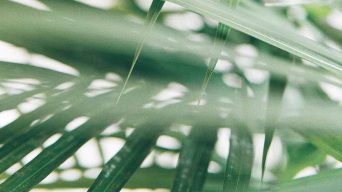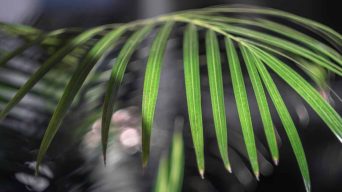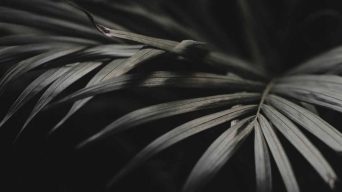Key Takeaways
- Overwatering or underwatering, inadequate humidity levels, pests and diseases, light issues, tap water use, overfertilization, or lack of nutrition in the soil can all cause majesty palm leaves to curl.
- To fix majesty palm leaves curling: adjust watering habits by watering 1-3 times a week depending on season and using distilled or rainwater; increase humidity through misting, a humidifier, pebble tray, grouping plants, and avoidance of heat sources; address pest and disease issues promptly through identification and treatment; address light issues through finding a balance between sunlight and shade or use of artificial lighting.
- Majesty palms require well-draining soil that retains moisture but doesn’t stay soggy. Use a good potting mix that contains peat moss, perlite sand/vermiculite. Regular fertilization with a balanced fertilizer formulated for palm trees is also important for proper nutrients.
Majesty palms, or Ravenea rivularis, are popular indoor houseplants known for their lush and vibrant foliage.
However, even the most well-cared-for palm tree can experience curling leaves – a sign that something isn’t quite right.
If your Majestic Palm is suffering from this issue, don’t worry!
This comprehensive guide will walk you through the common causes of Majesty Palm leaves curling and provide practical solutions to restore your plant to its former glory.
Causes Of Majesty Palm Leaves Curling
If you notice that the leaves of your Majesty Palm are curling, there could be several reasons for it.
This includes giving it too much or too little water, not providing enough humidity, dealing with pests or diseases, having insufficient light, using tap water, or not giving it enough nutrients.
Overwatering Or Underwatering
One common cause of curling leaves in Majesty Palms is improper watering, which can result from overwatering or underwatering.
Excessive watering can result in root rot, causing a lack of oxygen and essential nutrients for the roots.
This problem manifests through yellowed and drooping leaves that may eventually curl up.
To establish a proper watering routine for your majesty palm, use a moisture meter to determine when it’s time for another drink.
Ideally, you should water thoroughly until excess water drains out from the bottom of the pot, but avoid letting your Ravenna sit in a saucer filled with standing water.
If you’re unsure about whether you’ve provided enough hydration, insert your finger into the soil approximately an inch deep; if it feels dry at this depth, it’s time to add more water.
Inadequate Humidity
Inadequate humidity is a common cause of majesty palm leaves curling, as these tropical plants thrive in environments with high moisture levels in the air.
When the surrounding air is too dry, the plant loses water through transpiration at a faster rate than it can replace it, causing leaves to curl and become more susceptible to pests and diseases.
To combat inadequate humidity for your majestic palm (Ravenea rivularis), there are several methods you can employ.
Start by placing the potted plant on a tray filled with pebbles and water; as the water evaporates, it increases local humidity around your palm without soaking its roots.
Alternatively, consider investing in a humidifier to maintain optimal atmospheric conditions or group your palm with other houseplants that require moist environments – this creates microclimates with higher relative humidity.
Pests And Diseases
Pests and diseases can contribute to Majesty Palm leaves curling, creating stress for the plant and potentially hindering its growth.
Common pests that target these houseplants include spider mites, mealybugs, and aphids.
For instance, spider mite infestations can cause leaves to lose moisture and turn yellow or brown, eventually leading to curling if left untreated.
To combat pest invasion and disease issues in your indoor plants, it’s crucial to maintain a clean environment around them.
Start by regularly wiping the leaves with a damp cloth or using a spray bottle of water mixed with mild soap solution on both sides of each leaf.
It’s also important to prune away any dead or unhealthy-looking leaves using sanitized shears, as this will prevent further infection among your indoor palm trees.
Whenever possible, avoid overhead watering techniques since it leads to wet foliage – instead, try targeting the root ball directly while ensuring that excess water drains out properly from the potting soil for healthier growth.
Light Issues
Insufficient or excessive light can be a cause of majesty palm leaves curling.
Majesty Palms require bright, indirect light for healthy growth.
When placed in low-light conditions, the plant may struggle to photosynthesize and grow properly, resulting in curled leaves.
Providing the correct amount of light is crucial for solving majesty palm leaves curling.
Placing your plant near an east- or west-facing window or using artificial lighting can provide additional light to your indoor majesty palm tree.
It is important to avoid exposing your plant to sudden changes in light levels that could cause shock and lead to further leaf damage.
Tap Water
One of the lesser-known causes of Majesty Palm leaves curling is tap water.
Tap water can contain salts, minerals, chlorine, and fluoride that can harm your plant’s root system and cause yellowing or curling leaves.
To avoid this problem, using distilled or rainwater for watering your plants instead of tap water is recommended.
If you don’t have access to these alternatives, you can still use tap water but let it sit uncovered for a few hours before using it on your plant to allow some chemicals to evaporate.
Overfertilization
Overfertilization is another cause of Majesty Palm leaves curling.
When you provide more fertilizer than your palm needs, the excess salt accumulates in the soil and causes damage to the roots.
This eventually leads to leaf curling and other problems like yellowing or brown spots on the leaves.
First, to fix majesty palm leaves curling caused by overfertilization, leach out the soil with distilled water to remove any excess salt buildup.
Then adjust your fertilization schedule accordingly by reducing it to once a month or every two months using a balanced fertilizer.
Also, always check for signs of stress on your palms before adding fertilizer so you don’t accidentally cause more harm than good.
Lack Of Nutrition
Majesty palms require proper nutrition to grow and thrive.
When the plant lacks essential nutrients, it can cause the leaves to curl and turn yellow.
Nutrient deficiencies can occur due to several factors, such as insufficient nutrients in the soil, a nutrient imbalance, poor soil aeration, high soil pH levels, or an overall lack of nutrition.
To ensure adequate nutrition for your majesty palm, it is important to fertilize regularly with a balanced fertilizer formulated explicitly for palm trees.
You may also need to repot your plant into fresh soil with enough organic matter like peat moss or compost.
Soil Type
The type of soil your Majesty Palm is growing in can also contribute to leaf curling.
The palm prefers a well-draining soil that retains moisture but doesn’t stay soggy.
A good potting mix for the Majesty Palm should have peat moss, perlite, and sand or vermiculite.
Nutrient deficiencies due to poor soil aeration or high soil pH can cause Majesty Palm leaves to curl.
If your plant isn’t flourishing despite proper watering and light conditions, it may be time to change the soil entirely.
Remember not to pack too much fresh soil around the roots.
Gently pat down with your fingers until you’ve covered all exposed root areas with composted soils mixed with nutrients like nitrogen, potassium, and phosphorous for healthy growth.
How To Fix Curling Majesty Palm Leaves
Discover effective ways to remedy curling majesty palm leaves.
These methods involve modifying watering practices, boosting humidity levels, dealing with pest and disease problems, and other helpful solutions.
Adjust Watering Habits
To fix curling Majesty Palm leaves, adjusting your watering habits is essential.
Here’s what you need to do:
- Water your Majesty Palm 1-3 times a week, depending on the season and humidity levels.
- Before watering, check the top few inches of soil to ensure it’s dry.
- When you water, thoroughly saturate the soil until water drains out from the bottom of the pot.
- Don’t let your Majesty Palm sit in standing water, which can lead to root rot and other issues.
- If you’re unsure if your plant needs watering, use a moisture meter or stick your finger into the soil up to the second knuckle. If it feels dry at this depth, it’s time to water again.
- Remember to adjust your watering schedule during different seasons – Majesty Palms require less frequent watering during winter months.
Increase Humidity
If you notice the leaves of your majestic palm starting to curl, it could be due to low humidity levels.
Fortunately, there are several ways you can increase the humidity and prevent further damage to your plant.
Here are some practical ways to do so:
- Misting: One of the easiest and most effective ways to increase humidity is by misting the leaves regularly with a spray bottle filled with water.
- Humidifier: Investing in a humidifier is another great way to add moisture to the air around your plant.
- Pebble tray: Placing a tray filled with pebbles and water underneath the pot can also help increase humidity levels.
- Grouping plants: Grouping indoor plants can create a mini greenhouse effect and help maintain optimum humidity levels.
- Avoid heat sources: Avoid placing your plant near heat sources like radiators or heating vents, as they can dry out the air.
Address Pest And Disease Issues
It is essential to promptly address pest and disease issues in your Majesty Palm.
Here are some steps you can take to address these problems:
- Identify the problem: Look for signs of infestations or diseases, such as discoloration, spots, chewed leaves, or webs. Identifying the problem will help you select an appropriate treatment.
- Treat insect infestations: Use a natural insecticide like neem oil to eliminate pests like mealybugs and spider mites. You can also use rubbing alcohol on a cotton swab to remove mealybugs from leaves.
- Address fungal diseases: If you notice brown or black spots on the leaves or stems, it might be caused by a fungal infection. Trim off the infected areas using sterile shears, and discard the diseased tissue.
- Prevent future infections: Keep your palm tree healthy by avoiding overwatering or underwatering and practicing proper hygiene when handling your plant.
- Seek professional help: If unsure of what’s causing the problem, consult a plant expert or horticulturist for specialized advice or treatment options.
Prompt action can save your Majesty Palm from irreversible damage or death.
Address Light Issues
If your Majesty Palm leaves are curling, inadequate light exposure might also be the problem.
Here’s how to address it:
- Find a balance between sunlight and shade. Majesty Palms thrive in bright, indirect light, so you must ensure they are exposed to light for several hours each day without being in direct sunlight.
- Move your plant if necessary. If your palm isn’t getting enough light in its current location, move it closer to a window or place it in a brighter room.
- Consider investing in artificial lighting. If natural light isn’t enough, you can also use artificial lighting, such as grow lights, to give your Majesty Palm the right amount of light.
- Regularly clean the leaves of your palm plant. Ensure that nothing is blocking the sunlight from reaching the leaves of your Majesty Palm.
Remember that too much direct sun can cause problems and lead to burnt or browned leaves, but too little sunlight also causes curling.
Adjusting the position or providing artificial lighting can help fix the issue of Majesty Palm leaves curling due to insufficient light exposure.
Use Distilled Or Rainwater
Using distilled or rainwater can be beneficial to prevent common issues like brown tips on majesty palms.
Here’s why:
- Tap water can contain chemicals and minerals that may not be suitable for palm trees.
- The buildup of salt in soil from tap water can cause brown tips on leaves.
- Distilled or rainwater to flush the soil can prevent salt buildup and improve moisture retention.
- Washing your Majesty Palms with distilled or rainwater can also help remove dust and keep them looking green.
- Collecting rainwater is a cost-effective and eco-friendly option for watering your plants.
While tap water may suffice, switching to distilled or rainwater may result in healthier and happier palm trees.
Reduce Fertilization
Reducing fertilization is one way to fix Majesty Palm leaves curling.
Here are some tips on how to do it:
- Avoid using too much fertilizer as it can cause damage to the roots and reduce water intake, leading to leaf curling.
- Fertilize the plant every two to three months, as recommended, using a balanced palm fertilizer.
- Use less concentrated solutions when fertilizing your potted Majesty Palm.
- If you notice signs of overfertilization, such as brown or black spots on the leaves, flush the soil by running water through the pot until it comes out of the drainage holes.
- Wait until your Majesty Palm has fully recovered before resuming normal fertilization.
Remember, balancing fertilization, watering, humidity, and light is crucial for healthy growth in your Majesty Palm.
So use these tips together with others outlined in this guide to achieve optimal care for your plant!
Add Nutrients To The Soil
Enriching the soil with adequate nutrients is essential to prevent Majesty Palm leaves from curling.
Here are some ways to add important nutrients to your palm’s soil:
- Use a balanced fertilizer: A balanced fertilizer contains nitrogen, potassium, and phosphorus- all essential plant macronutrients. Apply this fertilizer every two or three months during the growing season.
- Add iron, magnesium, and manganese-rich fertilizers: These micronutrients play a vital role in plant health, particularly in preventing leaf curling. Check the label and ensure that the fertilizer contains soluble forms of these nutrients.
- Adjust soil pH: Your Majesty Palm requires a slightly acidic soil with a pH of 6-6.5 for optimal nutrient availability. Test your soil and adjust accordingly by adding lime or sulfur.
- Use compost or organic matter: Organic matter such as compost can improve soil structure and provide essential nutrients to facilitate healthy growth.
Adding too much fertilizer can cause root damage and further harm your plant.
Always follow package instructions and perform a soil test to determine nutrient deficiencies before changing your palace’s feeding schedule.
Change Soil Type
Changing soil type can be crucial to fix Majesty Palm leaves curling.
Here are some tips for changing the soil type of your majesty palm:
- Choose a well-draining soil mix that contains a blend of potting soil, sand, and peat moss.
- Ensure the new soil mix has good water retention capacity, allowing excess water to drain quickly.
- Remove the root ball from the old pot and shake off excess soil.
- Prepare a new pot with fresh soil mix and place the plant in it.
- Add more soil around the roots and gently press it down to eliminate air pockets.
- Water thoroughly until excess water comes out of the drainage holes at the bottom of the pot.
Remember to repot your majesty palm every 2-3 years using this method to keep it healthy and flourishing.
Proper soil type can help prevent overwatering or underwatering issues, which could cause your palm’s leaves to curl up.
Final Thoughts
Curling Majesty Palm leaves can be a stressful experience for any plant owner.
However, you can revive your beloved indoor palm tree by understanding the common causes and following the proper care guidelines.
Adjusting watering habits, increasing humidity levels, addressing pest and disease issues promptly, and providing adequate light are all key steps to take.
Remember to change soil type if necessary and add nutrients as required over time.







